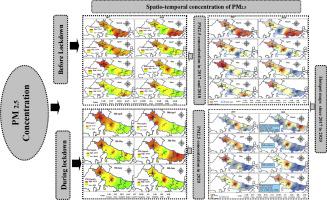Urban Climate ( IF 6.0 ) Pub Date : 2020-12-21 , DOI: 10.1016/j.uclim.2020.100758 Manob Das , Arijit Das , Sasanka Ghosh , Raju Sarkar , Sunil Saha

|
COVID-19 pandemic exhibited the entire world two aspects: human threats and environmental restoration. Due to pandemic, the nationwide lockdown in India imposed on 25 March and continued till 31 May 2020 in different phases. Again partial withdrawl of restrictions started from UnlockI (1–30 June 2020) to revive the Indian economy partially. The present research focused to assess impact of lockdown on the concentration of particulate matter (PM2.5) across the ten most polluted cities of Indo-Gangetic Plain of India alongwith incorporation of spatial distribution of PM2.5hotspots. It observed that during lockdown, the average concentration of PM2.5(μg/m3) across the cities decreased from 197 to 79 which is decrease of 60% since pre lockdown. In January 2020, the cities under considerations were in the category of ‘severe’ air quality index (AQI) but from March no cities fall under this category. The hotspot maps showed that in last three years (2017–2019), relatively higher concentration of PM2.5 was observed mostly around Delhi NCR but during same period of 2020 (lockdown and Unlock I), this concentartion decreased substantially. The findings of the study suggest that only by effective policies like short term lockdown, implementation of odd and even number motor vehicles, relocation of polluted industries need to be implemented by central and state governmental authorities to achive environmental sustainability.
中文翻译:

大流行期间大气颗粒物(PM 2.5)的时空浓度:对印度恒河平原大多数污染城市的研究
COVID-19大流行向全世界展示了两个方面:人类威胁和环境恢复。由于大流行,印度于3月25日实行全国封锁,并在不同阶段持续到2020年5月31日。从UnlockI(2020年6月1日至30日)再次开始部分取消限制,以部分恢复印度经济。本研究的重点是评估封锁对印度印支河平原平原十个污染最严重的城市中颗粒物(PM 2.5)浓度的影响,以及纳入PM 2.5热点的空间分布。据观察,在锁定期间,PM 2.5(μg/ m 3)从197个减少到79个,这是自锁定前以来减少了60%。2020年1月,考虑中的城市属于“严重”空气质量指数(AQI),但从3月开始,没有城市属于该类别。热点图显示,在过去三年中(2017-2019年),在德里NCR附近观察到相对较高的PM 2.5浓度,但在2020年同期(锁定和解锁I),该浓度大幅下降。研究结果表明,只有通过短期锁定,实施奇数和偶数机动车等有效政策,中央和州政府当局才需要对污染行业进行搬迁,以实现环境可持续性。









































 京公网安备 11010802027423号
京公网安备 11010802027423号